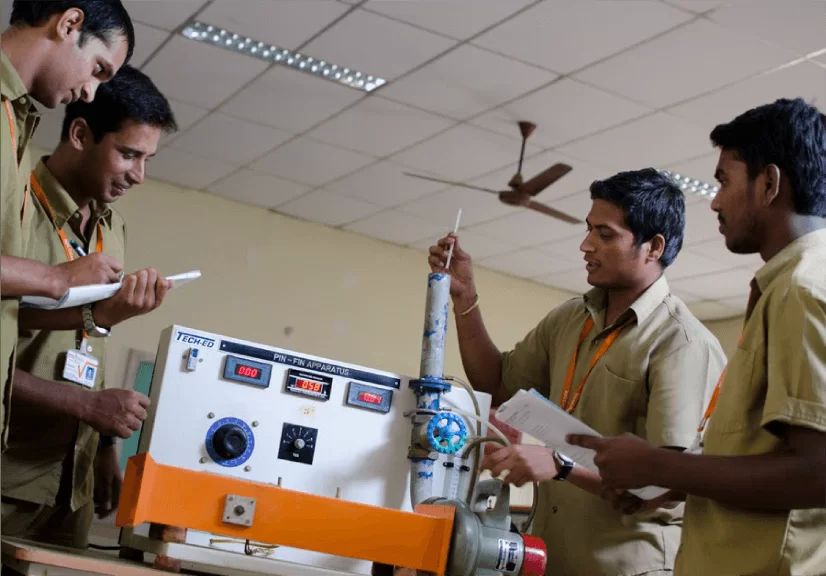Future Career, opportunities & scope in Civil engineering
Mar 21, 2024
Introduction
Have you ever driven through a highway and come across a bridge? Have you ever wondered what it takes to be a designer behind these massive constructions? This is exactly what civil engineers work on. They tend to discuss all the real-world challenges and take on these challenges to create certain dynamic technical developments. Are you also someone who is interested in the process of planning and constructing such big structures? Well, then this blog is just the right guide for you. Here we will discuss the scope in civil engineering and what the future holds for civil engineers along with an idea of the best engineering college in Bangalore.
Current Landscape of Civil Engineering
The increase in global population along with rapid urbanization has led to multiple challenges which range from climate change-induced infrastructure vulnerabilities to the complexity of urban sprawl and the need for sustainable construction materials. Innovations in civil engineering such as building information modeling also called Bim, advanced materials such as self-healing concrete and integration of AI has led to improvement of project conceptualization and its subsequent execution.
These innovations which are emerging are also in turn enhancing the accuracy and efficiency of engineering tasks while paving the way for more resilient, sustainable, and adaptive infrastructure. Some of the likely trends in civil engineering that are sure to provide a safer and more sustainable future can be listed as follows:
Green building materials
Civil engineers face a lot of challenges when it comes to excessive energy consumption in construction along with the environmental impact of construction waste. This is exactly why green building materials are now being innovated which reduces the need for frequent maintenance and repairs.
Renewable energy integration
Another one of the main challenges that most civil engineers face is the over-reliance on non-renewable energy resources. Therefore, there are multiple ways to bring in renewable energy sources in order to overcome these problems. Smart grids, solar energy, and wind energy are a few of such renewable energy integrations that are currently trending.
Advanced Robotics
As the number of projects related to civil engineering is on the rise, there are problems related to labor shortages, construction site safety, and the time-intensive nature of manual tasks. To tackle these issues, advanced robots are now enabling automated operation which also includes drone-powered autonomous site inspections.
Some of the key sectors where civil engineers are now high in demand can also be provided as follows:
- Transportation
- Construction and building
- Environmental engineering
- Geotechnical engineering
- Structural engineering
- Urban and regional planning
While the scope in civil engineering is wide and multiple opportunities are new and upcoming, there is still a lot of competition based on the skills you may carry. Here are some of the skills that are important to find the right job opportunity in the civil engineering field.
- High proficiency in physics and mathematics
- Technical skills
- Problem-solving skills
- Project management
- Verbal communication skills
- Teamwork
- Critical thinking skills
Emerging Technologies Shaping the Future of Civil Engineering
The field of civil engineering is always changing, particularly in terms of cutting-edge technologies. These developments are also changing the way we organize, create, build, and oversee a number of infrastructure development projects. The most recent technological developments are certain to change the industry as a whole, from increasing productivity to boosting safety and accuracy. Here are some examples of how technology is transforming the field of civil engineering.
A. Building Information Modeling (BIM)
The field of civil engineering is rapidly expanding, and building information modeling, or BIM is revolutionizing the planning, designing, and building of infrastructure. Using a collaborative approach known as BIM, building and infrastructure projects' digital representation can be created, managed, and visualized by architects, engineers, and contractors alike.
It enables accurate 3D modeling, simulation, clash detection and hence leading to reduced errors and conflicts during the construction process. BIM also helps seamless communication and coordination between stakeholders which results in cost savings, improved efficiency, and better project results.
B. Sustainable construction practices
Sustainable construction has now become increasingly important especially due to the environmental impact that various industrial wastes have been on the high. One of the key factors that help in sustainable construction is definitely the use of technology. Technology has also changed the way in which the construction industry is now functioning making it more cost-effective, environmentally friendly, and more efficient. Environmental engineering has hence also gained a lot of attention nowadays.
C. Smart cities and urban infrastructure
Smart cities and urban infrastructure development are now making use of smart buildings which are structures that use advanced technology to control and monitor various systems such as lighting, heating, and ventilation.
This allows for higher savings in terms of energy efficiency and cost expenditure. For example, sensors used in construction can detect when a room is completely empty and will automatically turn off the lights and adjust the temperature in such a way that energy is saved.
D. Advanced materials and construction techniques
Advanced construction practices consist of a wide array of innovative methods that go beyond traditional techniques. Geotechnical engineering helps students focus on this particular aspect. These techniques also use multiple cutting-edge technology and materials which help streamline the process of construction which makes it more sustainable, efficient, and cost-effective.
One such way where advanced construction techniques are used is by involving advanced building materials such as carbon fiber reinforced concrete, self-healing materials, and aerogels. These materials do not just offer enhanced strength and durability but also great insulation properties.
E. Virtual reality and augmented reality in construction
Virtual and augmented reality technologies are also changing the ways in which civil engineers envision and communicate their design plans. VR also enables immersive experience which allows engineers to explore multiple virtual environments and make better and more informed design decisions.
AR overlays virtual elements onto the real world while enhancing fieldwork in structural engineering and on-site construction by providing real-time information and visual guidance. These technologies also improve the collaboration terms among team members and facilitate better client communication.
Future Career Opportunities in Civil Engineering
Civil engineering is no doubt one of the highly professing courses. There is also a promising future and a wide scope in civil engineering field. Multiple job opportunities are available after pursuing a civil engineering degree. In civil engineering, students tend to learn all about the construction, design, and maintenance of physical and natural infrastructures. This in turn helps them ensure strength and usability for developing a particular environment. There are not just multiple job opportunities, these job opportunities are also equally rewarding.
Sustainable Infrastructure Development
Sustainable infrastructure development involves using renewable materials on building projects to reduce the consumption of energy and toxic waste. The primary goal of this particular initiative is to decrease the industry’s impact on the environment by utilizing various sustainable construction procedures.
One of the ways in which sustainability is implemented is with the help of green building construction. Green building practices mainly revolve around using eco-friendly materials implementing energy-efficient designs and reducing the building’s carbon footprint.
Other such methods involved can be provided as follows:
- Limiting the materials used to reduce construction project waste
- Controlling waste management by continuously recycling waste
- Conserving energy
Urban Development and Smart Cities
Urban planning involves the planning of cities for the future. It is a holistic and interdisciplinary field where practitioners consult with the residents and listen to their needs. Now based on this feedback obtained from the residents the civil engineers draft and implement landscapes where people can live, work, and play.
The main goal is to actualize the local aspirations into material reality by using the built environment. Smart cities are also the way forward where there will be integration of technology to obtain real-time data. Various technologies also contribute to the cause and include a combination of products, applications, analytics, and the Internet.
Infrastructure Rehabilitation and Maintenance
The need for infrastructure has been quite recently increasing along with the evolution and growth of our cities and communities. Once state-of-the-art designs, everything from water systems to bridges, roads, and power grids are now displaying numerous signs of wear and tear. The government is faced with an extremely challenging task because of this aging infrastructure. For this reason, appropriate maintenance and infrastructure rehabilitation are required.
Construction Technology and Innovation
Construction technology involves various specialized technologies that are used in the construction industry. Some of the examples are 3D printing of houses, AI, BIM Software, and many such technologies. These technologies consist of high scope in civil engineering and are helping highly in improving working conditions while also enhancing safety and health measures. Construction projects now also benefit from various efficient and effective solutions that allow to design, develop, and build structures with remarkable precision.
AI is going to play a huge role where it can increase productivity by handling repetitive tasks on its own. This helps strategize efficient construction processes and helps solve the problem of labor shortage crisis. 3D printing is also quite the rage where they help constructors to print three-dimensional shapes. Some of its advantages include waste reduction and flexibility in design. It also removes any human errors which might be caused in the manufacturing of materials especially when concrete is involved.
Education and Training for Future Civil Engineers
In order to pursue a career in civil engineering, you must first complete an undergraduate degree. From there, you can pursue a post-graduate degree. Some of the colleges also provide diplomas in civil engineering. Here are the options you can go for in order to pursue a career in civil engineering.
BTech in Civil Engineering
Btech in Civil Engineering is a four-year course that is conducted as a full-time program and is divided into a total of 8 semesters with each year consisting of 2 semesters.
Eligibility criteria
- The aspirants need to have passed 10 + 2 examinations or an equivalent exam with 45 to 50 percentage marks in Physics, Maths, and Chemistry.
- The admission process for BTech is conducted through the entrance exams such as KCET, MHCET, JEE Main, and JEE Advanced
- You can also check out MVJCE the best engineering college in Bangalore for further admissions.
MTech in Civil Engineering
This course is a full-time two-year program and will consist of 4 semesters
Eligibility criteria
- The students who have passed the BTech degree with a minimum passing percentage in all subjects of undergraduate programs can apply for MTech.
- The admissions are done through entrance exams such as GATE. The score merit list is referred to for ranking and admissions.
- Get the entire list of data for each civil engineering college in Bangalore based on its own prerequisites.
One of the main aspects of the civil engineering curriculum as far as scope in civil engineering is concerned is that there are practical experiences involved along with multiple options for internships. These internships are quite important as they provide real-world experience while connecting it with the coursework.
Not to mention the fact that civil engineering is an ever-changing industry with new technological advancements at every point. This is exactly why lifelong learning serves as a cornerstone for continuous professional development for civil engineers. This can be done by participating in attending conferences, and formal education, participating in workshops, and staying informed through professional publications. This will also ensure that the students are always on top of their technical expertise and are up to date with industry standards and best practices.
Conclusion
With the rapid growth of the population, the need for civil engineers is definitely on the rise. The scope in civil engineering is hence far and wide, ranging from transportation industries to environmental projects to even urban planning and disaster relief. Also, with evolving changes in this industry, there will surely be more and more opportunities that will be opened up in the future. So why wait anymore, when you can check out civil engineering college in Bangalore and secure your admission now?
FAQS:
What are some key sectors where civil engineers find employment?
Some of the key sectors where civil engineers find employment can be provided as follows:
- Waste management companies
- Utility companies
- Railways companies
- Engineering firms
- Construction companies
How can civil engineers contribute to sustainable development?
Civil engineers can contribute to sustainable development by incorporating green practices, renewable energy integration, resilient designs, smart technologies, and collaborative efforts. This in turn will shape the world such that there will be a balance between human development and environmental preservation.
What are the emerging technologies shaping the future of civil engineering?
Some of the emerging technologies that are shaping the future of civil engineering can be provided as follows:
- 3D printing
- BIM (Building information modeling)
- IoT (Internet of Things)
- Augmented and Virtual Reality (AR/VR)
- Robotics and drones
What career opportunities are available in urban development and smart cities for civil engineers?
Some of the career opportunities in urban development and smart cities for civil engineers can be provided as follows:
- Environmental engineering
- Transportation engineering
- Structural engineering
- Town planning
- Safety management
- Construction manager
How can civil engineers contribute to infrastructure rehabilitation and maintenance?
Civil engineers do not just take part in planning, designing, and executing of infrastructure but also take part in the maintenance of these structures by keeping a record of the condition and looking out for any wear and tear.








